Four Hypotheses for the Emergence of Israelite Society
Four Hypotheses for the Emergence of Israelite Society
Four Hypotheses for the Emergence of Israelite Society
You also want an ePaper? Increase the reach of your titles
YUMPU automatically turns print PDFs into web optimized ePapers that Google loves.
four_hypo<strong>the</strong>ses<br />
https://people.creighton.edu/~ngr39382/four_hypo<strong>the</strong>ses.htm<br />
Page 1 <strong>of</strong> 2<br />
7/26/2005<br />
[RETURN]<br />
THE EMERGENCE OF ISRAELITE SOCIETY<br />
<strong>Four</strong> <strong>Hypo<strong>the</strong>ses</strong><br />
I. CONQUEST HYPOTHESIS<br />
A. Leading Proponents: W. F. Albright, G. E. Wright, and Yigael Yadin<br />
B. Major features<br />
1. Con<strong>for</strong>ms most closely to <strong>the</strong> biblical account, affirming <strong>the</strong> biblical<br />
view that Israel invaded Canaan from <strong>the</strong> east, conquering its<br />
major cities through a military campaign.<br />
2. Its proponents cite 13th C BCE destruction levels at places like<br />
Hazor, Lachish, and Be<strong>the</strong>l.<br />
3. Its proponents cite evidence <strong>for</strong> widespread cultural change at turn<br />
<strong>of</strong> LB/IA<br />
C. Challenges<br />
1. Biblical “Israel” does not meet criteria <strong>for</strong> a mass migration.<br />
2. There is no evidence <strong>of</strong> cultural discontinuity at any <strong>of</strong> <strong>the</strong> sites.<br />
3. Many Transjordanian cities mentioned in <strong>the</strong> Bible did not exist at<br />
within <strong>the</strong> narrow span <strong>of</strong> time <strong>the</strong> conquest would have had to<br />
occur (13 th C BCE).<br />
4. Some “conquest” sites west <strong>of</strong> <strong>the</strong> Jordan River / Dead Sea rift,<br />
including Jericho and Arad, also show little or no habitation at <strong>the</strong><br />
13th C BCE level.<br />
5. The demise <strong>of</strong> LB culture appears to have been a gradual process,<br />
not a single event.<br />
II. PASTORAL NOMAD HYPOTHESIS<br />
A. Leading Proponents: Albrecht Alt and Martin Noth<br />
B. Major features<br />
1. States that Israel evolved from pastoral nomadism to agricultural<br />
sedentarism.<br />
2. Affirms singular identity <strong>of</strong> <strong>Israelite</strong>s as immigrants into Canaan.<br />
3. Posits that Israel waged war against <strong>the</strong> Canaanite city-states and<br />
<strong>the</strong>n engaged in territorial expansion only after it had consolidated<br />
itself as a nation.<br />
C. Challenges<br />
1. Modern anthropological <strong>the</strong>ory rejects assumptions that:<br />
a) nomads were isolated from o<strong>the</strong>r societies<br />
b) semi-nomadism marks a stage <strong>of</strong> development from nomadism<br />
to village farmer to urban dweller<br />
2. This nomadic origin cannot be located, nor can its path be traced.<br />
III. PEASANTS’ REVOLT HYPOTHESIS<br />
A. Leading Proponents: George Mendenhall and Norman Gottwald<br />
B. Major features<br />
1. Affirms that “Israel” consisted mainly <strong>of</strong> oppressed Canaanite<br />
peasants who rebelled against <strong>the</strong>ir overlords in <strong>the</strong> city-states and<br />
sought refuge in <strong>the</strong> highlands.<br />
2. Proponents cite datable destruction levels at some biblical sites<br />
mentioned as having been “conquered.”<br />
3. Proponents cite <strong>the</strong> decline <strong>of</strong> city-states in <strong>the</strong> LB period and<br />
concurrent population increases in <strong>the</strong> highlands as additional<br />
supporting evidence.
four_hypo<strong>the</strong>ses<br />
https://people.creighton.edu/~ngr39382/four_hypo<strong>the</strong>ses.htm<br />
Page 2 <strong>of</strong> 2<br />
7/26/2005<br />
4. Does not depend upon exclusive, external “<strong>Israelite</strong>” explanations.<br />
C. Challenges<br />
1. Unsupported by <strong>the</strong> archaeological record<br />
a) evidence <strong>for</strong> destruction levels at various city-states is not<br />
consistent.<br />
a) no evidence <strong>for</strong> a sizable rural component in <strong>the</strong> LB period.<br />
b) no evidence <strong>of</strong> a direct shift from lowlands to highlands LB/IA<br />
2. Relies too heavily on <strong>the</strong> classical Marxist model <strong>of</strong> socioeconomic<br />
change.<br />
IV. RURALIZATION HYPOTHESIS<br />
A. Leading Proponents: Lawrence Stager; now widely accepted.<br />
B. Major features<br />
1. Affirms that increased ruralization occurred largely as a result <strong>of</strong> <strong>the</strong><br />
Late Bronze Age decline <strong>of</strong> city-state systems, as peasant farmers<br />
and pastoralists moved fur<strong>the</strong>r away from <strong>the</strong> cities and settled in<br />
rural highlands.<br />
2. Does not depend upon exclusive, external “<strong>Israelite</strong>” explanations.<br />
C. Archaeological Evidence<br />
1. Nine areas were surveyed along both sides <strong>of</strong> <strong>the</strong> Jordan River.<br />
Findings:<br />
a) LB = 88 sites covering 500 acres = 50,000 people (100<br />
persons / acre)<br />
b) IA I = 678 sites covering 1,500 acres = 150,000 people (100<br />
persons / acre)<br />
2. Thus 93% <strong>of</strong> IA I sites were established as new foundations.<br />
3. Such massive population growth (300%) can only be attributed to a<br />
major influx <strong>of</strong> people into <strong>the</strong> highlands during <strong>the</strong> 12th--11th C<br />
BCE, including both peasant farmers and pastoralists, and<br />
perhaps some <strong>for</strong>mer urban dwellers as well.<br />
D. Conclusion: The evidence appears to indicate that ancient Israel<br />
emerged as a rural, kin-based tribal society engaged in both<br />
agriculture and animal herding (primarily sheep and goats), bearing no<br />
discernible cultural distinction from neighboring social groups. As<br />
Stager writes, “The evidence from language, costume, coiffure, and<br />
material remains suggest that <strong>the</strong> early <strong>Israelite</strong>s were a rural subset <strong>of</strong><br />
Canaanite culture and largely indistinguishable from Transjordanian<br />
rural cultures as well.”
















